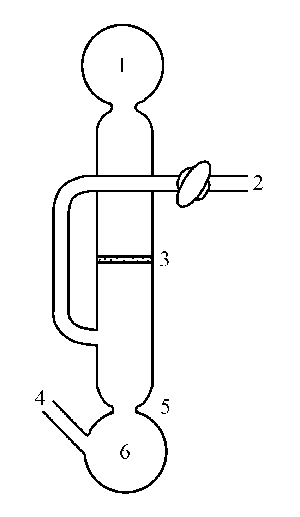Section 1: Product Identification
Chemical Name: Tungsten (IV) chloride, 97%
CAS Registry Number: 13470-13-8
Formula: WCl4
EINECS Number: none
Chemical Family: metal halide
Synonym: Tungsten tetrachloride
Section 2: Composition and Information on Ingredients
Ingredient CAS Number Percent ACGIH (TWA) OSHA (PEL)
Title Compound 13470-13-8 100% 1mg/m3 (as W - soluble) no data
Section 3: Hazards Identification
Corrosive to skin and eyes. Material hydrolyzes in contact with moisture releasing toxic and corrosive fumes
Emergency Overview:
of hydrogen chloride and aqueous hydrochloric acid.
Primary Routes of Exposure: Contact with skin and eyes. Inhalation of dust.
Eye Contact: Corrosive irritant to the eyes.
Skin Contact: Corrosive to skin.
Inhalation: Forms hydrogen chloride in the presence of moisture. Inhalation can lead to burning of the respiratory tract.
Ingestion: No information is available on the acute physiological effects of ingestion.
Corrosive to skin, eyes and respiratory tract. Causes eye and skin burns, dyspnea (difficulty breathing) and
Acute Health Affects:
pulmonary edema.
Chronic Health Affects: No information available on long-term chronic effects.
NTP: No
IARC: No
OSHA: No
SECTION 4: First Aid Measures
Immediately flush the eyes with copious amounts of water for at least 10-15 minutes. A victim may need
Eye Exposure:
assistance in keeping their eye lids open. Get immediate medical attention.
Wash the affected area with water. Remove contaminated clothes if necessary. Seek medical assistance if
Skin Exposure:
irritation persists.
Remove the victim to fresh air. Closely monitor the victim for signs of respiratory problems, such as difficulty
Inhalation:
in breathing, coughing, wheezing, or pain. In such cases seek immediate medical assistance.
Seek medical attention immediately. Keep the victim calm. Give the victim water (only if conscious). Induce
Ingestion:
vomiting only if directed by medical personnel.
SECTION 5: Fire Fighting Measures
Flash Point: not applicable
Autoignition Temperature: none
Explosion Limits: none
Extinguishing Medium: None. Material is non-flammable.
If this product is involved in a fire, fire fighters should be equipped with a NIOSH approved positive pressure
Special Fire Fighting Procedures:
self-contained breathing apparatus and full protective clothing.
Hazardous Combustion and If involved in a fire this material may emit toxic fumes of hydrogen chloride.
Decomposion Products:
Unusual Fire or Explosion Hazards: No unusual fire or explosion hazards.
SECTION 6: Accidental Release Measures
Small spills can be mixed with powdered sodium bicarbonate, lime, or calcium carbonate and swept up. Avoid
Spill and Leak Procedures:
raising dust.
SECTION 7: Handling and Storage
Store solid in a tightly sealed bottle away from moisture. If possible, handle solid in an efficient fume hood.
Handling and Storage:
Prolonged exposure to the atmosphere will lead to degradation of the product.
SECTION 8: Exposure Controls and Personal Protection
Eye Protection: Always wear approved safety glasses when handling a chemical substance in the laboratory.
Skin Protection: Wear protective clothing and gloves. Consult with glove manufacturer to determine the proper type of glove.
Ventilation: The solid may form corrosive vapors. It should be handled in an efficient fume hood.
If in form of fine dust and ventilation is not available a respirator should be worn. The use of respirators
Respirator:
requires a Respirator Protection Program to be in compliance with 29 CFR 1910.134.
Ventilation: The solid may form corrosive vapors. It should be handled in an efficient fume hood.
Additional Protection: No additional protection required.
SECTION 9: Physical and Chemical Properties
Color and Form: gray pwdr.
Molecular Weight: 325.66
Melting Point: no data
Boiling Point: no data
Vapor Pressure: no data
Specific Gravity: 4.624
Odor: pungent odor
Solubility in Water: reacts with water
SECTION 10: Stability and Reactivity
Stability: moisture sensitive
Hazardous Polymerization: no hazardous polymerization
Conditions to Avoid: contact with moisture
Incompatibility: active metals
Decomposition Products: Tungsten oxychloride, hydrogen chloride
SECTION 11: Toxicological Information
RTECS Data: No information available in the RTECS files.
Carcinogenic Effects: no data
Mutagenic Effects: no data
Tetratogenic Effects: no data
SECTION 12: Ecological Information
Ecological Information: No information available
SECTION 13: Disposal Considerations
Disposal: Dispose of according to local, state and federal regulations.
SECTION 14: Transportation
Shipping Name (CFR): Corrosive Solids, N.O.S.
Hazard Class (CFR): 8
Additional Hazard Class (CFR): NA
Packaging Group (CFR): II
UN ID Number (CFR): UN# 1759
Shipping Name (IATA): Corrosive Solid, N.O.S.
Hazard Class (IATA): 8
Additional Hazard Class (IATA): NA
Packaging Group (IATA): II
UN ID Number (IATA): UN# 1759
SECTION 15: Regulatory Information
TSCA: Not listed in the TSCA inventory.
SARA (Title 313): Title compound not listed.
Second Ingredient: none
SECTION 16 - ADDITIONAL INFORMATION
N/A
 基本信息
展开↓
基本信息
展开↓  生产制备方法及用途展开↓
生产制备方法及用途展开↓
 物化性质展开↓
物化性质展开↓  安全信息展开↓
安全信息展开↓  MSDS 展开↓
MSDS 展开↓ 分子结构与计算化学数据展开↓
分子结构与计算化学数据展开↓  上下游相关产品
上下游相关产品